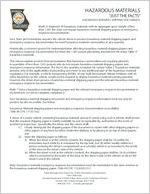HAZARDOUS MATERIALS
"JUST THE FACTS"
HAZARDOUS MATERIAL SHIPPING DOCUMENTS:
Myth: A shipment of hazardous materials with an aggregate gross weight of less than 1,001 lbs. does not require hazardous material shipping papers or emergency response documentation.
Fact: State and Federal law requires the vehicle driver to possess hazardous material shipping papers and emergency response documentation for most hazardous material commodities in any quantity.
Historically, a common ground for misinterpretation affecting hazardous material shipping papers and emergency response documentation has been the 1,001 pound placarding requirement for many "table 2" hazardous materials.
This misconception ascends from presumption that hazardous commodities not requiring placards in quantities of less than 1,001 pounds also do not require hazardous material shipping papers and emergency response information. The fact is, the quantity exception for certain "table 2" hazardous materials pertains only to the applicability of placarding and never to any additional part of the hazardous material regulations. For example, a vehicle transporting 900 lbs. of non-bulk Ammonium Nitrate Fertilizer, with no other hazardous on the vehicle, would not be required to display hazardous material warning placards; however, the driver must possess a hazardous material shipping paper and the relevant hazardous material emergency response documentation.
Myth: "I have a hazardous material shipping paper and the relevant emergency response documentation in my briefcase, so I am in complete compliance."
Fact: Hazardous material shipping documents and emergency response information must not only be present, by also accessible. See below.
Hazardous Material shipping papers and emergency response documentation accessibility: (Title 49 CFR, 177.817(e))
A driver of a motor vehicle containing hazardous material, and each carrier using such a vehicle, shall ensure that the required shipping paper is readily available to, and recognizable by, authorities in the event of accident or inspection. Specifically, the driver and the carrier shall:
(1) Clearly distinguish the shipping paper, if the document is carried with other shipping papers or other papers of any kind, by either distinctive tabbing or by placing in on top of other papers; and
(2) Store the shipping paper as follows: (i) When the driver is at the vehicle controls, the shipping paper shall be: (A) within his immediate reach while he is restrained by the lap belt; and (B) either readily visible to a person entering the driver's compartment or in a holder which is so mounted to the inside of the door on the driver's side of the vehicle. (ii) When the driver is not at the vehicle's controls, the shipping paper shall be: (A) in a holder which is mounted to the inside of the door on the driver's side of the vehicle; or (B) on the driver's seat in the vehicle.
Note: Hazardous material emergency response documentation must be maintained in the same manner as the hazardous material shipping paper. (Title 49 CFR, 172.602(C)(1))
Safety Message from Project P.I.E. (Public Information and Education) FACT SHEET #06
Georgia Department of Public Safety, Motor Carrier Compliance Division P.O. Box 1456, Atlanta, Georgia 30371-1456 (404) 624-7211 www.dps.georgia.gov
